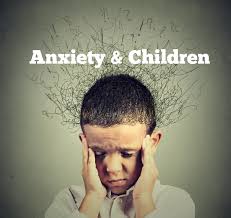Dealing with Anxiety in Children
Dealing with Anxiety in Children
Children with anxiety difficulties tend to lack confidence in their abilities and feel overwhelmed easily. They are also driven to avoid the things that cause them anxiety, and in doing so, don’t get the chance to learn that what they fear will usually not happen. You can help by working on coping and problem-solving skills together.
When children are chronically anxious, even the most well-meaning parents can fall into a negative cycle and, not wanting a child to suffer, actually exacerbate the youngster’s anxiety. It happens when parents, anticipating a child’s fears, try to protect her from them. Here are pointers for helping children escape the cycle of anxiety.
1. Don’t Eliminate it, Manage it.
No parent wants to see a child unhappy, but the best way to help kids overcome anxiety isn’t to try to remove stressors that trigger it. It’s to help them learn to tolerate their anxiety and function, as well as they, can, even when they’re anxious. And that will help the anxiety decrease or fall away over time.
- Freeze— pause and take some deep breaths with your child. Deep breathing can help reverse the nervous system response.
• Empathize— anxiety is scary. Your child wants to know that you get it.
• Evaluate — once your child is calm, it’s time to figure out possible solutions.
• Let Go – Let go of your guilt; you are an amazing parent giving your child the tools to manage their worry.
2. Don’t avoid things just because they make the child anxious.
Helping children avoid the things they are afraid of will make them feel better in the short term, but it reinforces the anxiety over the long run. If a child in an uncomfortable situation gets upset, starts to cry—not to be manipulative, but just because that’s how she feels—and her parents whisk her out of there, or remove the thing she’s afraid of, she’s learned that coping mechanism and that cycle has the potential to repeat itself.
Let’s say your child is afraid of sitting on the swings in the park. Instead of avoiding this activity, create mini-goals to get closer to the bigger goal (e.g., go to the edge of the park, then walk into the park, go to the swings, and, finally, get on a swing). You can use each step until the exposure becomes too easy; that’s when you know it’s time to move to the next rung on the ladder.
3. Respect their feelings, but don’t empower them.
It’s important to understand that validation doesn’t always mean agreement. So if a child is terrified about going to the doctor because she’s due for a shot, you don’t want to belittle her fears, but you also don’t want to amplify them. You want to listen and be empathetic, help her understand what she’s anxious about, and encourage her to feel that she can face her fears. The message you want to send is, “I know you’re scared, and that’s okay, and I’m here, and I’m going to help you get through this.”
4. Don’t ask leading questions.
Encourage your child to talk about her feelings, but try not to ask leading questions— “Are you anxious about the big test? Are you worried about the science fair?” To avoid feeding the cycle of anxiety, just ask open-ended questions: “How are you feeling about the science fair?”
5. Express positive—but realistic—expectations.
You can’t promise a child that her fears are unrealistic—that she won’t fail a test, or get hurt while playing. But you can express confidence that she’s going to be okay, she will be able to manage it, and that, as she faces her fears, the anxiety level will drop over time. This gives her confidence that your expectations are realistic, and that you’re not going to ask her to do something she can’t handle.
6. Don’t reinforce the child’s fears.
What you don’t want to do is be saying, with your tone of voice or body language: “Maybe this is something that you should be afraid of.” Let’s say a child has had a negative experience with a dog. Next time she’s around a dog, you might be anxious about how she will respond, and you might unintentionally send a message that she should, indeed, be worried.
7. Try to keep the anticipation short.
When we’re afraid of something, the hardest time is really before we do it. So another rule of thumb for parents is to really try to eliminate or reduce the anticipatory period. If a child is nervous about going to a doctor’s appointment, you don’t want to launch into a discussion about it two hours before you go; that’s likely to get your child more keyed up. So just try to shorten that period to a minimum.
8. Think things through.
Sometimes it helps to talk through what would happen if a child’s fear came true—how would she handle it? A child who’s anxious about separating from her parents might worry about what would happen if they didn’t come to pick her up. So we talk about that. And what do you think the teacher would do? “Well she would call my mom. Or she would wait with me.” A child who’s afraid that a stranger might be sent to pick her up can have a code word from her parents that anyone they sent would know. For some kids, having a plan can reduce the uncertainty in a healthy, effective way.
9. Try to model healthy ways of handling anxiety.
There are multiple ways you can help kids handle anxiety by letting them see how you cope with anxiety yourself. Kids are perceptive, and they’re going to take it in if you keep complaining on the phone to a friend that you can’t handle the stress or the anxiety. You don’t have to pretend that you don’t have stress and anxiety, but letting kids hear or see you managing it calmly, tolerating it, feeling good about getting through it will help them execute it themselves.
Please leave your comments and feedback below. Thanks for reading!
- Effects of Psychotherapy on Parental Stress - November 21, 2023
- Couple’s Therapy: Navigating marital issues as a parent - June 9, 2023
- Talk Therapy for stuttering - May 31, 2023




Leave a Comment
(2 Comments)
Well writtten post .Practical,concise and doable tips were listed.
Thanks !i look forward to more of such useful writeups!!sahayee good job ????
Thank you Jayshree! 🙂
Categories
Recent Posts